What Animals Were On The Lifeboat With Pi
Marine biological science is the scientific study of the biology of marine life, organisms in the ocean. Given that in biological science many phyla, families and genera have some species that alive in the sea and others that alive on land, marine biological science classifies species based on the environment rather than on taxonomy.
A large proportion of all life on Globe lives in the ocean. The exact size of this big proportion is unknown, since many bounding main species are still to be discovered. The ocean is a complex 3-dimensional world[ane] covering approximately 71% of the Earth's surface. The habitats studied in marine biology include everything from the tiny layers of surface water in which organisms and abiotic items may exist trapped in surface tension between the ocean and temper, to the depths of the oceanic trenches, sometimes 10,000 meters or more beneath the surface of the ocean. Specific habitats include estuaries, coral reefs, kelp forests, seagrass meadows, the surrounds of seamounts and thermal vents, tidepools, muddied, sandy and rocky bottoms, and the open up sea (pelagic) zone, where solid objects are rare and the surface of the water is the only visible boundary. The organisms studied range from microscopic phytoplankton and zooplankton to huge cetaceans (whales) 25–32 meters (82–105 feet) in length. Marine environmental is the written report of how marine organisms collaborate with each other and the environs.
Marine life is a vast resources, providing food, medicine, and raw materials, in addition to helping to back up recreation and tourism all over the world. At a fundamental level, marine life helps determine the very nature of our planet. Marine organisms contribute significantly to the oxygen bicycle, and are involved in the regulation of the Earth's climate.[2] Shorelines are in part shaped and protected past marine life, and some marine organisms even assistance create new land.[3]
Many species are economically important to humans, including both finfish and shellfish. Information technology is also becoming understood that the well-being of marine organisms and other organisms are linked in central ways. The human body of knowledge regarding the relationship between life in the body of water and important cycles is rapidly growing, with new discoveries being made nigh every day. These cycles include those of matter (such as the carbon cycle) and of air (such as Earth's respiration, and movement of energy through ecosystems including the ocean). Big areas below the ocean surface all the same remain effectively unexplored.
Biological oceanography [edit]
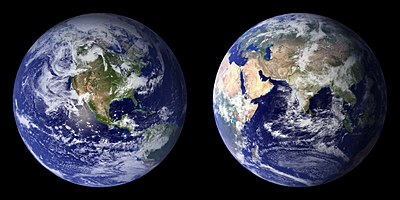
Marine biology studies species that live in marine habitats. Almost of the Earth's surface is covered by ocean, which is the home to marine life. Oceans average well-nigh four kilometers in-depth and are fringed with coastlines that run for about 360,000 kilometres.[iv] [5]
Marine biology tin be contrasted with biological oceanography. Marine life is a field of study both in marine biological science and in biological oceanography. Biological oceanography is the study of how organisms touch and are affected by the physics, chemistry, and geology of the oceanographic system. Biological oceanography mostly focuses on the microorganisms inside the ocean; looking at how they are afflicted by their environment and how that affects larger marine creatures and their ecosystem.[6] Biological oceanography is similar to marine biological science, only it studies ocean life from a different perspective. Biological oceanography takes a bottom up arroyo in terms of the nutrient web, while marine biology studies the ocean from a elevation down perspective. Biological oceanography mainly focuses on the ecosystem of the ocean with an emphasis on plankton: their diversity (morphology, nutritional sources, motility, and metabolism); their productivity and how that plays a role in the global carbon cycle; and their distribution (predation and life wheel).[6] [seven] [viii] Biological oceanography also investigates the role of microbes in food webs, and how humans bear upon the ecosystems in the oceans.[vi] [9]
Marine habitats [edit]
Marine habitats can exist divided into coastal and open ocean habitats. Coastal habitats are constitute in the surface area that extends from the shoreline to the edge of the continental shelf. Well-nigh marine life is plant in coastal habitats, fifty-fifty though the shelf area occupies just seven percent of the total sea area. Open bounding main habitats are found in the deep bounding main beyond the edge of the continental shelf. Alternatively, marine habitats can be divided into pelagic and demersal habitats. Pelagic habitats are found near the surface or in the open water column, away from the lesser of the ocean and affected past ocean currents, while demersal habitats are near or on the bottom. Marine habitats can be modified by their inhabitants. Some marine organisms, like corals, kelp and bounding main grasses, are ecosystem engineers which reshape the marine environment to the point where they create further habitat for other organisms.
Intertidal and near shore [edit]

Intertidal zones, the areas that are close to the shore, are constantly being exposed and covered by the bounding main's tides. A huge assortment of life tin be found inside this zone. Shore habitats span from the upper intertidal zones to the area where country vegetation takes prominence. Information technology can be underwater anywhere from daily to very infrequently. Many species here are scavengers, living off of sea life that is washed upward on the shore. Many land animals also make much use of the shore and intertidal habitats. A subgroup of organisms in this habitat bores and grinds exposed rock through the procedure of bioerosion.
Estuaries [edit]

Estuaries have shifting flows of body of water water and fresh h2o.
Estuaries are also nigh shore and influenced by the tides. An estuary is a partially enclosed coastal bounding main with one or more rivers or streams flowing into it and with a free connection to the open sea.[10] Estuaries form a transition zone between freshwater river environments and saltwater maritime environments. They are subject both to marine influences—such as tides, waves, and the influx of saline h2o—and to riverine influences—such as flows of fresh h2o and sediment. The shifting flows of both sea water and fresh water provide high levels of nutrients both in the water column and in sediment, making estuaries among the most productive natural habitats in the world.[xi]
Reefs [edit]
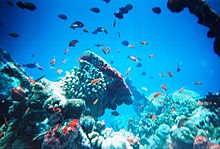
Reefs comprise some of the densest and well-nigh diverse habitats in the world. The best-known types of reefs are tropical coral reefs which exist in near tropical waters; however, reefs can too exist in cold water. Reefs are congenital up by corals and other calcium-depositing animals, usually on height of a rocky outcrop on the sea floor. Reefs can besides grow on other surfaces, which has fabricated it possible to create bogus reefs. Coral reefs besides support a huge community of life, including the corals themselves, their symbiotic zooxanthellae, tropical fish and many other organisms.
Much attending in marine biology is focused on coral reefs and the El Niño weather miracle. In 1998, coral reefs experienced the nigh astringent mass bleaching events on record, when vast expanses of reefs beyond the world died because bounding main surface temperatures rose well higher up normal.[12] [thirteen] Some reefs are recovering, simply scientists say that between 50% and seventy% of the world's coral reefs are now endangered and predict that global warming could exacerbate this trend.[fourteen] [15] [16] [17]
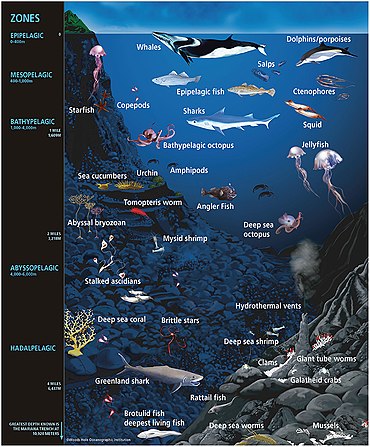
Some representative ocean animal life (not fatigued to calibration) inside their approximate depth-defined ecological habitats. Marine microorganisms exist on the surfaces and within the tissues and organs of the various life inhabiting the ocean, across all ocean habitats.[18]
Open ocean [edit]
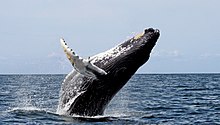
The open ocean is relatively unproductive because of a lack of nutrients, however because it is and then vast, in total it produces the most primary productivity. The open ocean is separated into different zones, and the different zones each take different ecologies.[19] Zones which vary co-ordinate to their depth include the epipelagic, mesopelagic, bathypelagic, abyssopelagic, and hadopelagic zones. Zones which vary past the amount of lite they receive include the photic and aphotic zones. Much of the aphotic zone'southward energy is supplied by the open ocean in the class of detritus.
Deep sea and trenches [edit]
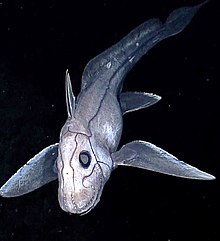
A deep-bounding main chimaera. Its snout is covered with tiny pores capable of detecting animals past perturbations in electric fields.
The deepest recorded oceanic trench measured to date is the Mariana Trench, near the Philippines, in the Pacific Sea at 10,924 m (35,840 ft). At such depths, h2o force per unit area is extreme and at that place is no sunlight, but some life still exists. A white flatfish, a shrimp and a jellyfish were seen past the American crew of the bathyscaphe Trieste when it dove to the bottom in 1960.[xx] In full general, the deep ocean is considered to start at the aphotic zone, the point where sunlight loses its power of transference through the water.[21] Many life forms that alive at these depths take the ability to create their own low-cal known as bio-luminescence. Marine life besides flourishes around seamounts that ascent from the depths, where fish and other sea life congregate to spawn and feed. Hydrothermal vents forth the mid-ocean ridge spreading centers act equally oases, as do their opposites, common cold seeps. Such places back up unique biomes and many new microbes and other lifeforms have been discovered at these locations.[22]
Marine life [edit]


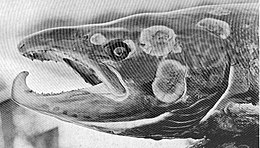
Mature salmon with fungal disease


Albatross hovering over the ocean looking for prey

In biology many phyla, families and genera take some species that live in the bounding main and others that live on country. Marine biological science classifies species based on the surround rather than on taxonomy. For this reason marine biology encompasses not but organisms that live only in a marine environment, but also other organisms whose lives revolve around the sea.
Microscopic life [edit]
As inhabitants of the largest surround on Earth, microbial marine systems drive changes in every global system. Microbes are responsible for about all the photosynthesis that occurs in the body of water, as well every bit the cycling of carbon, nitrogen, phosphorus and other nutrients and trace elements.[23]
Microscopic life undersea is incredibly diverse and still poorly understood. For example, the role of viruses in marine ecosystems is barely existence explored even in the beginning of the 21st century.[24]
The function of phytoplankton is better understood due to their disquisitional position as the most numerous primary producers on World. Phytoplankton are categorized into cyanobacteria (likewise called blue-dark-green algae/bacteria), diverse types of algae (ruby, greenish, dark-brown, and yellow-green), diatoms, dinoflagellates, euglenoids, coccolithophorids, cryptomonads, chrysophytes, chlorophytes, prasinophytes, and silicoflagellates.
Zooplankton tend to be somewhat larger, and not all are microscopic. Many Protozoa are zooplankton, including dinoflagellates, zooflagellates, foraminiferans, and radiolarians. Some of these (such as dinoflagellates) are also phytoplankton; the distinction between plants and animals ofttimes breaks downward in very small organisms. Other zooplankton include cnidarians, ctenophores, chaetognaths, molluscs, arthropods, urochordates, and annelids such every bit polychaetes. Many larger animals brainstorm their life equally zooplankton earlier they become large enough to accept their familiar forms. Two examples are fish larvae and body of water stars (also called starfish).
Plants and algae [edit]
Microscopic algae and plants provide of import habitats for life, sometimes interim as hiding places for larval forms of larger fish and foraging places for invertebrates.
Algal life is widespread and very diverse under the ocean. Microscopic photosynthetic algae contribute a larger proportion of the earth's photosynthetic output than all the terrestrial forests combined. Virtually of the niche occupied past sub plants on land is actually occupied by macroscopic algae in the body of water, such every bit Sargassum and kelp, which are unremarkably known every bit seaweeds that create kelp forests.
Plants that survive in the sea are oftentimes found in shallow waters, such equally the seagrasses (examples of which are eelgrass, Zostera, and turtle grass, Thalassia). These plants have adapted to the high salinity of the ocean environment. The intertidal zone is also a skillful place to find plant life in the sea, where mangroves or cordgrass or beach grass might grow.
Invertebrates [edit]
As on land, invertebrates make up a huge portion of all life in the body of water. Invertebrate sea life includes Cnidaria such every bit jellyfish and sea anemones; Ctenophora; sea worms including the phyla Platyhelminthes, Nemertea, Annelida, Sipuncula, Echiura, Chaetognatha, and Phoronida; Mollusca including shellfish, squid, octopus; Arthropoda including Chelicerata and Crustacea; Porifera; Bryozoa; Echinodermata including starfish; and Urochordata including ocean squirts or tunicates. Invertebrates take no backbone. There are over a meg species.
Fungi [edit]
Over ten,000[25] species of fungi are known from marine environments.[26] These are parasitic on marine algae or animals, or are saprobes on algae, corals, protozoan cysts, sea grasses, woods and other substrata, and tin can also be found in sea foam.[27] Spores of many species have special appendages which facilitate attachment to the substratum.[28] A very diverse range of unusual secondary metabolites is produced by marine fungi.[29]
Vertebrates [edit]
Fish [edit]
A reported 33,400 species of fish, including bony and cartilaginous fish, had been described by 2016,[30] more than all other vertebrates combined. About 60% of fish species live in saltwater.[31]
Reptiles [edit]
Reptiles which inhabit or frequent the bounding main include sea turtles, sea snakes, terrapins, the marine iguana, and the saltwater crocodile. Most extant marine reptiles, except for some sea snakes, are oviparous and need to return to land to lay their eggs. Thus most species, excepting sea turtles, spend near of their lives on or nigh land rather than in the body of water. Despite their marine adaptations, about bounding main snakes prefer shallow waters nearby land, effectually islands, particularly waters that are somewhat sheltered, also as nearly estuaries.[32] [33] Some extinct marine reptiles, such as ichthyosaurs, evolved to be viviparous and had no requirement to return to state.
Birds [edit]
Birds adapted to living in the marine environs are often called seabirds. Examples include albatross, penguins, gannets, and auks. Although they spend most of their lives in the ocean, species such every bit gulls can often be plant thousands of miles inland.
Mammals [edit]
There are five primary types of marine mammals, namely cetaceans (toothed whales and baleen whales); sirenians such as manatees; pinnipeds including seals and the walrus; body of water otters; and the polar acquit. All are air-breathing, and while some such as the sperm whale can dive for prolonged periods, all must render to the surface to breathe.[34] [35]
Subfields [edit]
The marine ecosystem is large, and thus at that place are many sub-fields of marine biology. Well-nigh involve studying specializations of detail creature groups, such as phycology, invertebrate zoology and ichthyology. Other subfields study the physical effects of continual immersion in sea water and the body of water in general, accommodation to a salty surroundings, and the effects of changing various oceanic properties on marine life. A subfield of marine biological science studies the relationships betwixt oceans and bounding main life, and global warming and ecology issues (such equally carbon dioxide displacement). Recent marine biotechnology has focused largely on marine biomolecules, especially proteins, that may take uses in medicine or engineering. Marine environments are the home to many exotic biological materials that may inspire biomimetic materials.
[edit]
Marine biological science is a branch of biology. It is closely linked to oceanography, specially biological oceanography, and may be regarded as a sub-field of marine scientific discipline. Information technology also encompasses many ideas from ecology. Fisheries science and marine conservation tin exist considered partial offshoots of marine biology (as well every bit environmental studies). Marine Chemistry, Physical oceanography and Atmospheric sciences are closely related to this field.
Distribution factors [edit]
An active enquiry topic in marine biological science is to notice and map the life cycles of various species and where they spend their time. Technologies that aid in this discovery include pop-up satellite archival tags, acoustic tags, and a variety of other data loggers. Marine biologists report how the sea currents, tides and many other oceanic factors affect sea life forms, including their growth, distribution and well-existence. This has only recently get technically feasible with advances in GPS and newer underwater visual devices.[ commendation needed ]
Most sea life breeds in specific places, nests or non in others, spends time every bit juveniles in still others, and in maturity in yet others. Scientists know trivial nigh where many species spend different parts of their life cycles specially in the babe and juvenile years. For example, it is even so largely unknown where juvenile sea turtles and some year-ane sharks travel. Recent advances in underwater tracking devices are illuminating what we know nigh marine organisms that live at great Body of water depths.[36] The information that pop-up satellite archival tags give aids in certain time of the year fishing closures and development of a marine protected surface area. This data is of import to both scientists and fishermen considering they are discovering that by restricting commercial fishing in one modest area they can accept a large bear on in maintaining a healthy fish population in a much larger expanse.
History [edit]
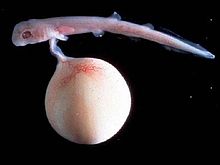
The study of marine biology dates back to Aristotle (384–322 BC), who made many observations of life in the bounding main effectually Lesbos, laying the foundation for many futurity discoveries.[38] In 1768, Samuel Gottlieb Gmelin (1744–1774) published the Historia Fucorum, the first work dedicated to marine algae and the first volume on marine biology to use the new binomial classification of Linnaeus. It included elaborate illustrations of seaweed and marine algae on folded leaves.[39] [twoscore] The British naturalist Edward Forbes (1815–1854) is generally regarded as the founder of the science of marine biology.[41] The pace of oceanographic and marine biological science studies speedily accelerated during the course of the 19th century.

The observations fabricated in the first studies of marine biology fueled the age of discovery and exploration that followed. During this time, a vast corporeality of cognition was gained about the life that exists in the oceans of the world. Many voyages contributed significantly to this pool of cognition. Amid the most pregnant were the voyages of HMSBeagle where Charles Darwin came up with his theories of evolution and on the formation of coral reefs.[42] Another important expedition was undertaken by HMS Challenger, where findings were fabricated of unexpectedly high species variety amongst animate being stimulating much theorizing by population ecologists on how such varieties of life could be maintained in what was thought to be such a hostile environment.[43] This era was important for the history of marine biology but naturalists were still limited in their studies because they lacked engineering that would permit them to adequately examine species that lived in deep parts of the oceans.
The creation of marine laboratories was important because it allowed marine biologists to conduct enquiry and process their specimens from expeditions. The oldest marine laboratory in the world, Station biologique de Roscoff, was established in Concarneau, France founded by the Higher of France in 1859.[44] In the United States, the Scripps Establishment of Oceanography dates dorsum to 1903, while the prominent Woods Pigsty Oceanographic Institute was founded in 1930.[45] The development of engineering science such as sound navigation ranging, scuba diving gear, submersibles and remotely operated vehicles immune marine biologists to discover and explore life in deep oceans that was once thought to non exist.[46]
See also [edit]
- Acoustic ecology
- Aquaculture
- Bathymetry
- Biological oceanography
- Effects of climate change on oceans
- Freshwater biological science
- Modular ocean model
- Oceanic basin
- Oceanic climate
- Phycology
Lists [edit]
- Glossary of ecology
- Alphabetize of biology articles
- Large marine ecosystem
- List of ecologists
- List of marine biologists
- Listing of marine ecoregions (WWF)
- Outline of biology
- Outline of environmental
References [edit]
- ^ Oceanographic and Bathymetric Features Marine Conservation Institute. Uploaded xviii September 2013.
- ^ Foley, Jonathan A.; Taylor, Karl E.; Ghan, Steven J. (1991). "Planktonic dimethylsulfide and cloud albedo: An estimate of the feedback response". Climatic Change. 18 (1): 1. Bibcode:1991ClCh...18....1F. doi:10.1007/BF00142502. S2CID 154990993.
- ^ Sousa, Wayne P. (1986) [1985]. "7, Disturbance and Patch Dynamics on Rocky Intertidal Shores". In Pickett, Steward T. A.; White, P. Southward. (eds.). The Ecology of Natural Disturbance and Patch Dynamics . Academic Press. ISBN978-0-12-554521-1.
- ^ Charette, Matthew; Smith, Walter H. F. (2010). "The book of Earth's ocean". Oceanography. 23 (2): 112–114. doi:10.5670/oceanog.2010.51.
- ^ World The World Factbook, CIA. Retrieved thirteen January 2014.
- ^ a b c Lalli, Carol M., and Timothy R. Parsons. "Introduction." Biological Oceanography: An Introduction. First Edition ed. Tarrytown, New York: Pergamon, 1993. 7-21. Print.
- ^ Menden-Deuer, Susanne. "Class Info, OCG 561 Biological Oceanography". Archived from the original on 2018-01-29. Retrieved 2021-03-19 .
- ^ Miller, Charles B.; Patricia A. Wheeler (2012). Biological Oceanography (Second ed.). Chinchester, West Sussex: John Wiley & Sons.
- ^ Mills, Eric Fifty. (1995). "From marine ecology to biological oceanography". Helgoländer Meeresuntersuchungen. 49 (ane–4): 29–44. Bibcode:1995HM.....49...29M. doi:10.1007/BF02368334. S2CID 22149101.
- ^ Pritchard, D. W. (1967). "What is an estuary: physical viewpoint". In Lauf, G. H. (ed.). Estuaries. A.A.A.Due south. Publ. Vol. 83. Washington, DC. pp. 3–five.
- ^ McLusky, D. Southward.; Elliott, M. (2004). The Estuarine Ecosystem: Ecology, Threats and Management. New York: Oxford University Printing. ISBN978-0-19-852508-0.
- ^ NOAA (1998) Record-breaking coral bleaching occurred in tropics this year. National Oceanic and Atmospheric Administration, Press release (October 23, 1998).
- ^ ICRS (1998) Argument on Global Coral Bleaching in 1997-1998. International Coral Reef Society, October 15, 1998.
- ^ Bryant, D., Burke, L., McManus, J., et al. (1998) "Reefs at take chances: a map-based indicator of threats to the globe's coral reefs". Earth Resources Institute, Washington, D.C.
- ^ Goreau, T. J. (1992). "Bleaching and Reef Community Change in Jamaica: 1951 - 1991". Am. Zool. 32 (half-dozen): 683–695. doi:10.1093/icb/32.6.683.
- ^ Sebens, Yard. P. (1994). "Biodiversity of Coral Reefs: What are We Losing and Why?". Am. Zool. 34: 115–133. doi:10.1093/icb/34.1.115.
- ^ Wilkinson, C. R., and Buddemeier, R. Westward. (1994) "Global Climate Change and Coral Reefs:Implications for People and Reefs". Report of the UNEP-IOC-ASPEI-IUCN Global Task Squad on the Implications of Climate change on Coral Reefs. IUCN, Gland, Switzerland.
- ^ Apprill, A. (2017)"Marine brute microbiomes: toward understanding host–microbiome interactions in a changing ocean". Frontiers in Marine Science, 4: 222. doi:10.3389/fmars.2017.00222.
 Fabric was copied from this source, which is available under a Creative Commons Attribution iv.0 International License.
Fabric was copied from this source, which is available under a Creative Commons Attribution iv.0 International License. - ^ "The Open up Ocean - MarineBio.org". marinebio.org . Retrieved 2016-09-26 .
- ^ Seven Miles Down: The Story of The Bathyscaph Trieste. Archived 2007-02-02 at the Wayback Machine, Rolex Deep Sea Special, January 2006.
- ^ "Aphotic Zone | Encyclopedia.com". www.encyclopedia.com . Retrieved 2018-12-06 .
- ^ Priede, Imants One thousand. (ten August 2017). Deep-Bounding main Fishes: Biology, Diversity, Ecology and Fisheries. pp. 12–13. ISBN9781107083820.
- ^ "Functions of global ocean microbiome key to agreement environmental changes". www.sciencedaily.com. University of Georgia. Dec ten, 2015. Retrieved December 11, 2015.
- ^ Suttle, C.A. (2005). "Viruses in the Ocean". Nature. 437 (9): 356–361. Bibcode:2005Natur.437..356S. doi:10.1038/nature04160. PMID 16163346. S2CID 4370363.
- ^ Amend, Anthony; Burgaud, Gaetan; Cunliffe, Michael; Edgcomb, Virginia P.; Ettinger, Cassandra Fifty.; Gutiérrez, M. H.; Heitman, Joseph; Hom, Erik F. Y.; Ianiri, Giuseppe; Jones, Adam C.; Kagami, Maiko (2019-03-05). "Fungi in the Marine Environment: Open Questions and Unsolved Bug". mBio. doi:10.1128/mBio.01189-18.
- ^ Hyde, K.D.; E.B.J. Jones; E. Leaño; S.B. Pointing; A.D. Poonyth; L.50.P. Vrijmoed (1998). "Role of fungi in marine ecosystems". Biodiversity and Conservation. 7 (ix): 1147–1161. doi:10.1023/A:1008823515157. S2CID 22264931.
- ^ Kirk, P.M., Cannon, P.F., Minter, D.West. and Stalpers, J. "Lexicon of the Fungi". Edn x. CABI, 2008
- ^ Hyde, K.D.; E.B.J. Jones (1989). "Spore attachment in marine fungi". Botanica Marina. 32 (3): 205–218. doi:10.1515/botm.1989.32.3.205. S2CID 84879817.
- ^ San-Martín, A.; S. Orejanera; C. Gallardo; M. Silva; J. Becerra; R. Reinoso; M.C. Chamy; Chiliad. Vergara; J. Rovirosa (2008). "Steroids from the marine fungus Geotrichum sp". Journal of the Chilean Chemical Guild. 53 (1): 1377–1378. doi:x.4067/S0717-97072008000100011.
- ^ "Fishbase". Retrieved 6 February 2017.
- ^ Moyle, P. B.; Leidy, R. A. (1992). Fiedler, P. L.; Jain, S. A. Jain (ed.). Loss of biodiversity in aquatic ecosystems: Evidence from fish faunas. Conservation Biological science: the theory and practice of nature conservation, preservation, and management. Chapman and Hall. pp. 128–169.
{{cite book}}: CS1 maint: multiple names: authors list (link) - ^ Stidworthy J. 1974. Snakes of the World. Grosset & Dunlap Inc. 160 pp. ISBN 0-448-11856-4.
- ^ Sea snakes [ permanent expressionless link ] at Food and Agriculture Arrangement of the United nations. Accessed 7 Baronial 2007.
- ^ Kaschner, One thousand.; Tittensor, D. P.; Prepare, J.; Gerrodette, T.; Worm, B. (2011). "Current and Future Patterns of Global Marine Mammal Biodiversity". PLOS ONE. half dozen (5): e19653. Bibcode:2011PLoSO...619653K. doi:10.1371/journal.pone.0019653. PMC3100303. PMID 21625431.
- ^ Pompa, South.; Ehrlich, P. R.; Ceballos, Grand. (2011-08-16). "Global distribution and conservation of marine mammals". Proceedings of the National Academy of Sciences. 108 (33): 13600–13605. Bibcode:2011PNAS..10813600P. doi:x.1073/pnas.1101525108. PMC3158205. PMID 21808012.
- ^ "March 2014 Newsletter - What's Going on at Desert Star".
- ^ Leroi, Armand Marie (2014). The Lagoon: How Aristotle Invented Science. Bloomsbury. pp. 72–74. ISBN978-one-4088-3622-4.
- ^ "History of the Report of Marine Biological science - MarineBio.org". MarineBio Conservation Society. Web. Mon, March 31, 2014. <http://marinebio.org/oceans/history-of-marine-biology.asp Archived 2014-03-03 at Annal-Information technology>
- ^ Gmelin S G (1768) Historia Fucorum Ex typographia Academiae scientiarum, Saint petersburg.
- ^ Silva PC, Basson Prisoner of war and Moe RL (1996) Catalogue of the Benthic Marine Algae of the Indian Sea page 2, University of California Press. ISBN 9780520915817.
- ^ "A Cursory History of Marine Biology and Oceanography". Retrieved 31 March 2014.
- ^ Ward, Ritchie R. Into the ocean globe; the biological science of the sea. 1st ed. New York: Knopf; [distributed by Random Business firm], 1974: 161
- ^ Gage, John D., and Paul A. Tyler. Deep-sea biology: a natural history of organisms at the deep-sea flooring. Cambridge: Cambridge University Press, 1991: 1
- ^ "A History Of The Study Of Marine Biological science ~ MarineBio Conservation Club". 2018-06-17. Retrieved 2022-02-17 .
- ^ Maienschein, Jane. 100 years exploring life, 1888-1988: the Marine Biological Laboratory at Forest Pigsty. Boston: Jones and Bartlett Publishers, 1989: 189-192
- ^ Anderson, Genny. "Beginnings: History of Marine Scientific discipline".
Further references [edit]
- Morrissey J and Sumich J (2011) Introduction to the Biology of Marine Life Jones & Bartlett Publishers. ISBN 9780763781606.
- Mladenov, Philip V., Marine Biology: A Very Brusk Introduction, 2d edn (Oxford, 2020; online edn, Very Brusque Introductions online, February. 2020), http://dx.doi.org/10.1093/actrade/9780198841715.001.0001, accessed 21 Jun. 2020.
External links [edit]
- Smithsonian Bounding main Portal
- Marine Conservation Order
- Marine biological science at Curlie
- Marine Ecology - an evolutionary perspective
- Free special result: Marine Biology in Time and Infinite
- Creatures of the deep ocean – National Geographic documentary, 2010.
- Exploris
- Freshwater and Marine Image Bank - From the University of Washington Library
- Marine Grooming Portal - Portal grouping training initiatives in the field of Marine Biological science
Source: https://en.wikipedia.org/wiki/Marine_biology
Posted by: duncanfachaps00.blogspot.com

0 Response to "What Animals Were On The Lifeboat With Pi"
Post a Comment